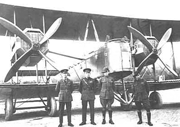E-Archive
Off the Beaten Track
in Vol. 7 - November Issue - Year 2006
Flying High...

The crew members in front of the Vickers Vimy used in the first flight to be completed from England to Australia in 1919.
"Ladies and gentlemen, we have commenced our descent and in a few minutes we will be landing at Singapore Changi Airport. Our in-flight program is ending and our flight attendants will be passing by shortly to collect your headphones.”
The young man groaned as he realized that there would not be enough time to watch the last, crucial minutes of the action movie which had been capturing his attention for over an hour.
In a sour mood, he turned his gaze to the window and peered down at the thick, gray clouds which were rapidly rising to greet him. He wondered if they were still flying over the sea or if the plane had already reached land.
* * * * * * * * * * * * * * *
The young man peered down at the thick, gray clouds. He wondered if they were flying over water or over land. The roar of the engines and the wind rushing over his goggles made dialogue almost impossible. “Jim, how’s the fuel?”, he snapped at his mechanic, whose elbow was pressing into his ribs. Jim Bennett had come to learn his captain’s quirks and could read his mood at a glance. As he shouted out a number, his mind went back to the many miles which the four men had covered in the past 23 days. The present leg of their journey, from Rangoon to Singapore, was also one of the most treacherous, since it covered more than a thousand miles over jungle country, where a forced landing would have meant disaster. Since take off, their plane had been tossed about by a monsoon which had formed over the Bay of Bengal, forcing them to make an unscheduled landing at Singora. The aircraft’s wooden frame creaked and a small tear in the fabric covering on the fuselage flapped violently as they entered the clouds. It seemed as if only the steel wires crisscrossing between the two wings kept the plane from falling apart.
They had left Hounslow, near London, on the cold and foggy morning of November 12th, 1919. The grass field was covered with snow and the weather had been declared “totally unfit for flying”. This did not deter Captain Ross Smith and his crew, composed of his brother Lieutenant Keith Smith and their two mechanics, Sergeant Jim Bennett and Sergeant Wally Shiers. Ross Smith had acquired considerable flying experience during World War I and by co-piloting the first flight from Cairo to Calcutta in 1918. In those years, aviation records were being set and broken in rapid succession, with a new breed of daring young men willing to risk life and limb by pushing themselves and their machines to higher and higher limits. Ross now had his heart set on an even greater achievement and on winning a prize of £10,000 offered by the Commonwealth Government of Australia for the first flight to be completed from Great Britain to Australia within thirty days.
This journey would take the four young Australians via Lyon, Rome, Crete, Cairo, Damascus, Basra, Karachi, Delhi, Calcutta, Akyab, Rangoon, Singapore, Batana and Surabaya before finally arriving at Darwin, with numerous stopovers in-between.
They were flying a Vickers Vimy, a biplane with a wooden frame and fabric covering, fitted with two 12-cylinder Rolls-Royce Eagle engines with four-bladed wooden propellers. It was 44 feet long, with a wingspan of 68 feet and a cruising speed of about ninety miles per hour. It took 26 minutes to reach an altitude of 5,000 feet. Fully equipped, the machine weighed 12,000 lbs., including 500 gallons of fuel, but had no radio, too heavy to be taken aboard!
All four men were silent as they stared intently, hoping, waiting. “There!”, shouted Keith as he grabbed his brother by the arm and pointed downwards. The clouds had started to thin out and suddenly the Malayan coast appeared in clear detail. The aircraft seemed to jump at the sight of Singapore shimmering in the distance. Ross Smith pointed the nose of the plane downward as his brother began spotting landmarks. They circled majestically above the old racecourse at Farrer Road and, moments later, the crowd ran towards them as the plane slowly rolled to a stop on the smooth, green turf. The first plane to land in Singapore had arrived in the late afternoon of Thursday, 4th December 1919. They would go on to complete their journey in 28 days, covering a distance of over 11,000 miles with an actual flying time of 135 hours.
By Giovanni Gregorat, Contributing Editor MFN
& Sales Manager, Pometon S.p.A.
Author: Giovanni Gregorat



























